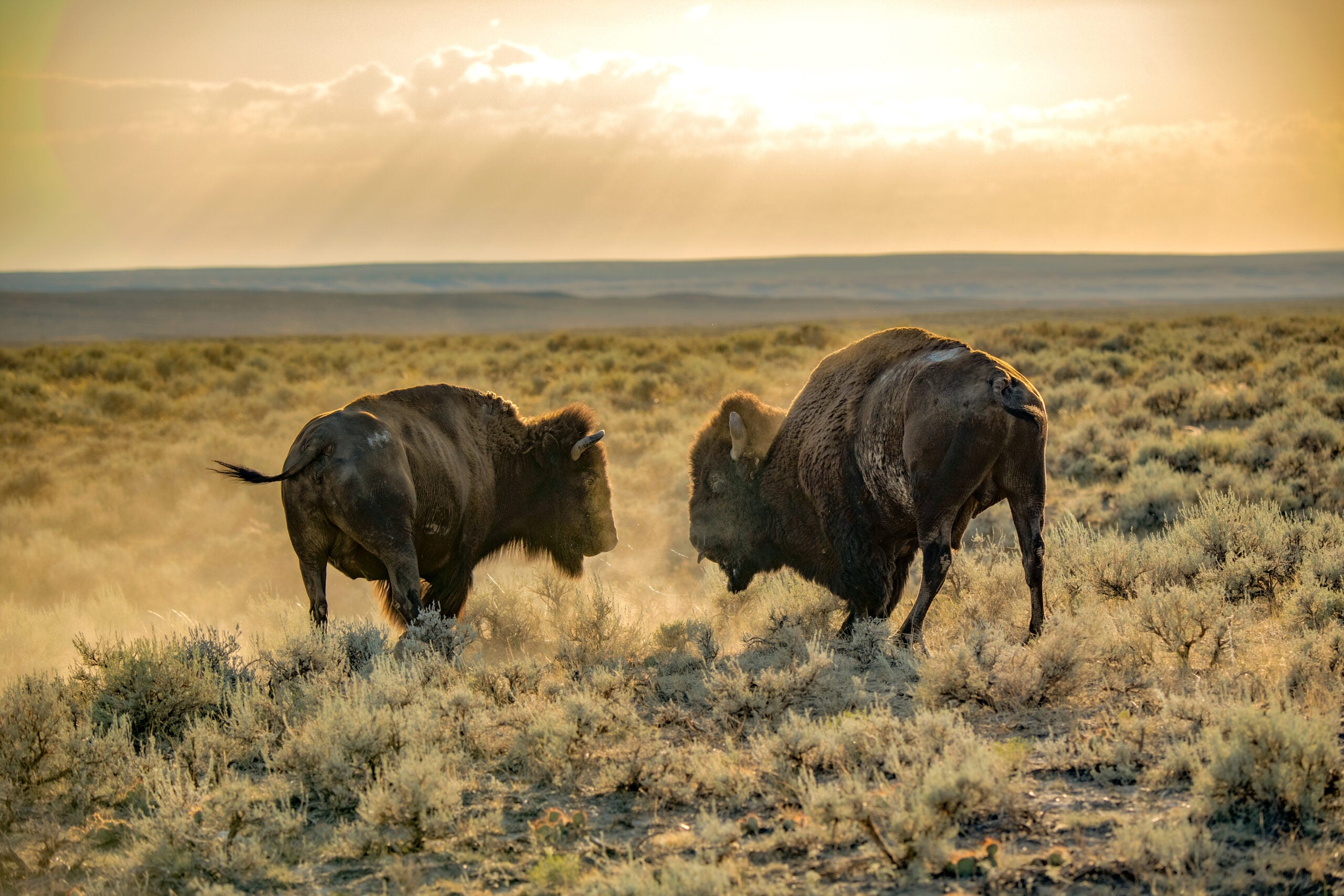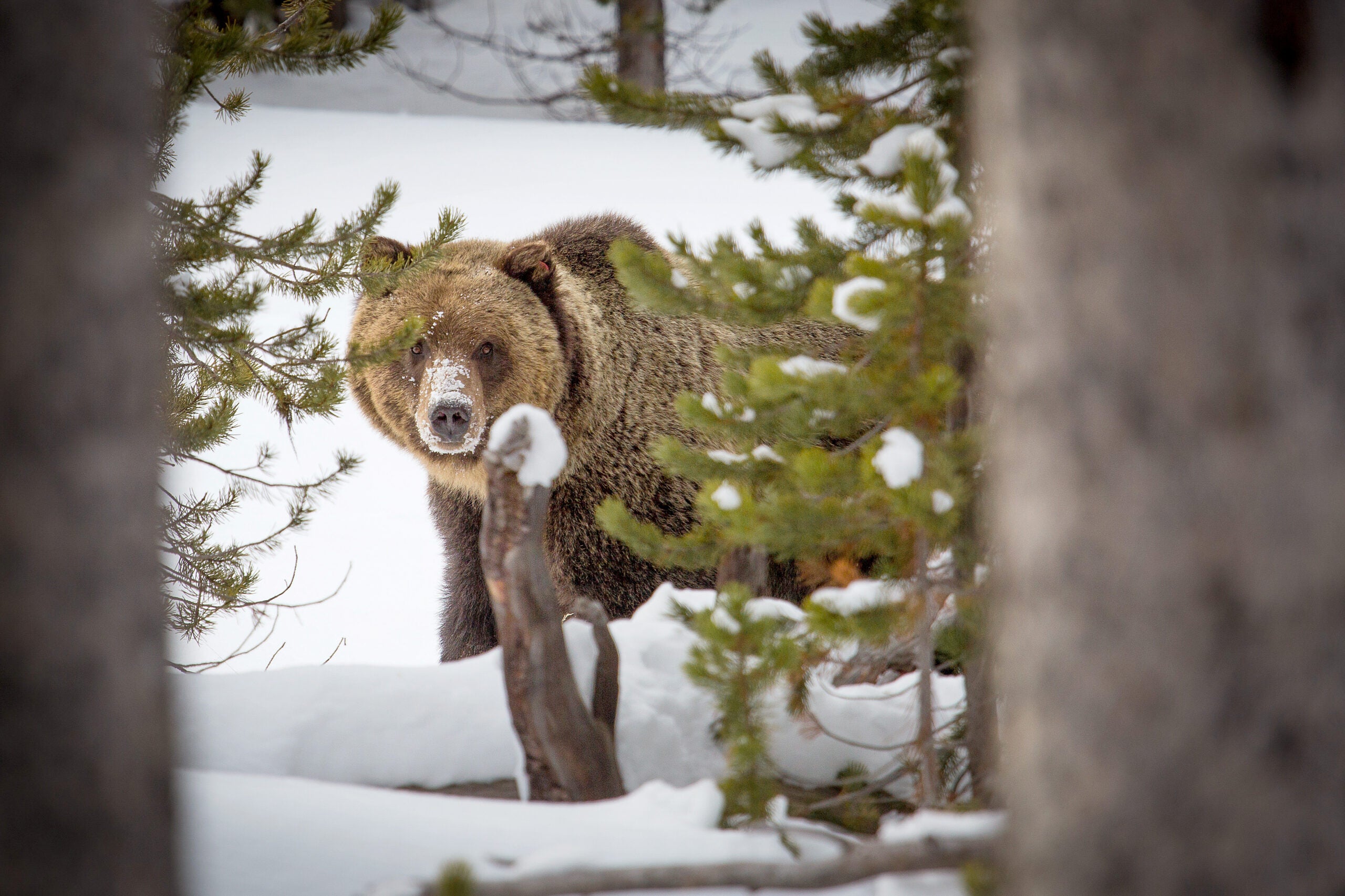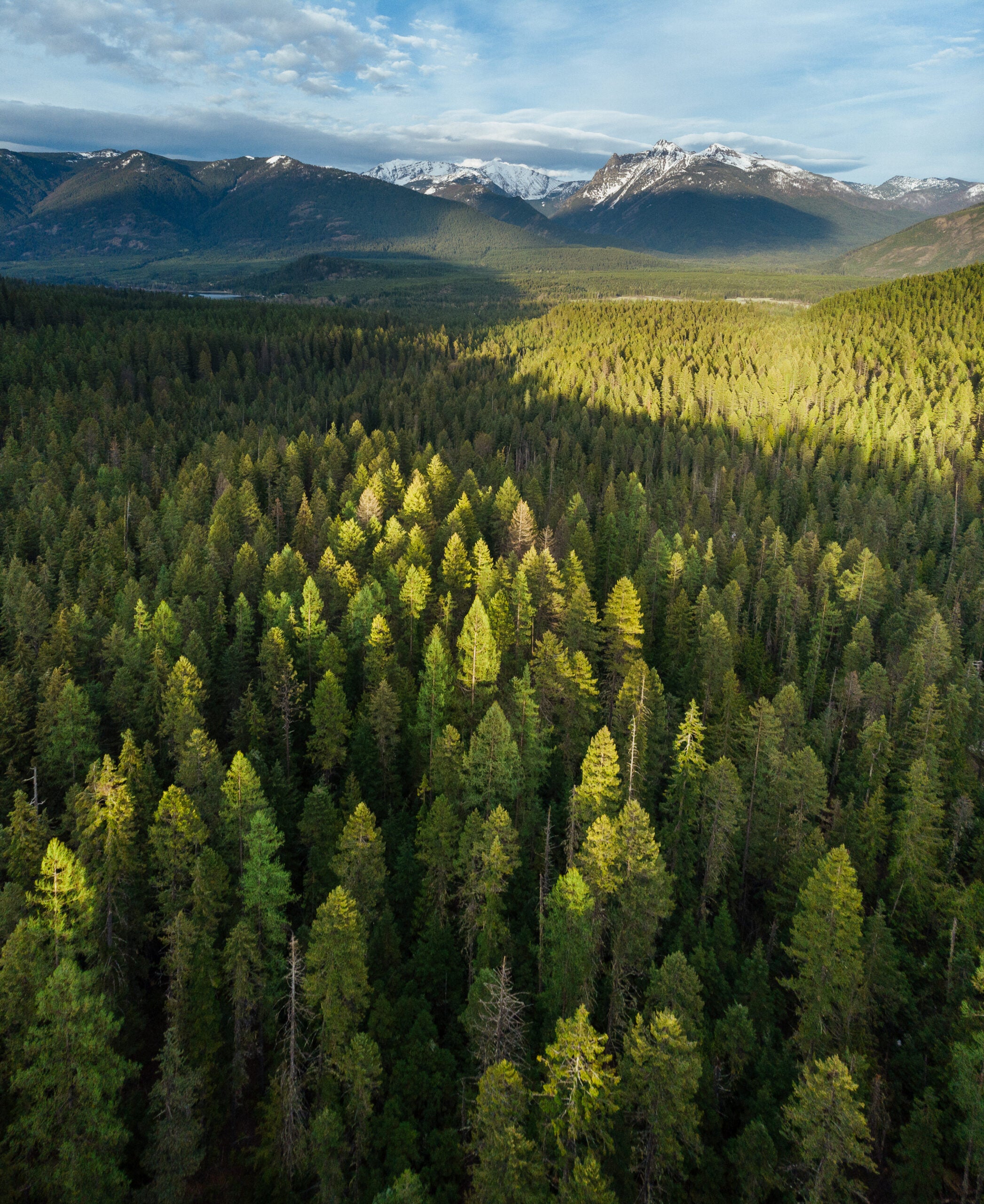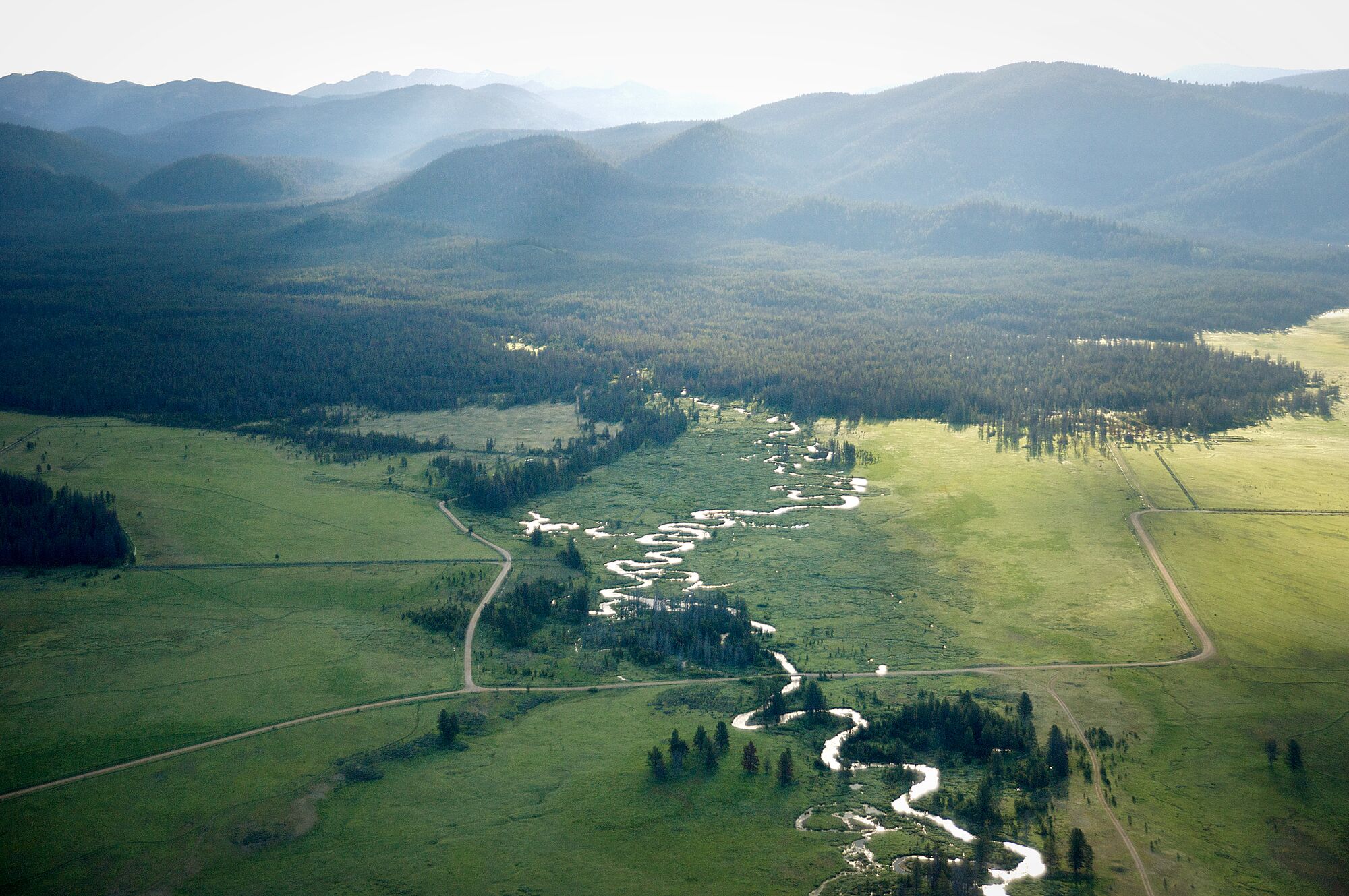August 7, 2023
Northern Rockies
A report prepared for Justice Partners

Northern Rockies Office at a Glance
Location: Bozeman, MT
Founded: 1993
Total staff: 10
Attorneys: 7
Regional focus: Idaho, Montana, Wyoming
Signature work: Protecting land, air, and water from mining, oil and gas development, and roadbuilding
Safeguarding imperiled species and intact ecosystems
Protecting gray wolves, grizzly bears, and other imperiled species
Ensuring a just transition from fossil fuels to renewable energy sources
Strengthening partnerships with regional Indigenous communities as they protect their lands and culture
For three decades, Earthjustice’s Northern Rockies office has leveraged the power of partnership and the law to defend communities, sacred lands and wildlife, and clean air and water. This magnificent region boasts some of the last large, intact temperate-zone ecosystems on the planet, which support imperiled species such as grizzly bears, wolverines, bison, and ever-persecuted gray wolves.
The Northern Rockies also contains some of the world’s largest reserves of coal and gas, the extraction and burning of which threatens ecosystems and communities here, and beyond. Just as air and water pollution are uncontained by state lines, environmental protections — or lack thereof — have impacts downwind, downstream, and everywhere else. As we work locally to protect our collective health and our cherished homelands, we face a perfect storm of opposition: deregulatory agendas at the federal level, hostile entrenched industry bad actors, and anti-environmental legislation throughout the Northern Rockies states.
Northern Rockies Office at a Glance
Location: Bozeman, MT
Founded: 1993
Total staff: 10
Attorneys: 7
Regional focus: Idaho, Montana, Wyoming
Signature work: Protecting land, air, and water from mining, oil and gas development, and roadbuilding
Safeguarding imperiled species and intact ecosystems
Protecting gray wolves, grizzly bears, and other imperiled species
Ensuring a just transition from fossil fuels to renewable energy sources
Strengthening partnerships with regional Indigenous communities as they protect their lands and culture
A key theme of our current work is defeating bad state environmental policies that exploit wildlife, promote fossil fuels, and impede the public’s access to the courts. In this work and across our docket, we center our partnerships with tribes and frontline communities. Making the best use of our platform, we serve as key conveners and elevate the wisdom of the people most impacted, who deserve the most influence in decisions about their air, water, and ecosystems.
Every day, we push for progress, telling the stories of people throughout the region to shift power dynamics and effect durable change. Below, we’re pleased to share a few highlights of our work.
Biodiversity on the Brink
We are part of a complex web of ecosystems and species that anchors all life on Earth. This web is unraveling, and roughly one million of the planet’s estimated eight million species face the urgent threat of extinction. While we’ve safeguarded the Northern Rockies’ large, undeveloped ecosystems for decades, including the Greater Yellowstone and Crown-of-the-Continent ecosystems, there’s new urgency to protect these lands as intact refugia from growing threats elsewhere. We use litigation to defend species that require large landscapes to thrive, and in doing so, secure entire ecosystems in which all species, including people, can also prosper.
Bison. Millions of bison once roamed the United States. But by the end of the 19th century, they were nearly driven to extinction by White settlers who slaughtered them to eliminate a key food source for Native Americans and clear the land for colonization. The bison here today are descendants of the last wild bison that survived the slaughter of the 19th century.
Our office has supported bison in the Greater Yellowstone Ecosystem for decades. These efforts helped the population to rebound from two dozen individuals to around 6,000 today. But for bison to thrive, they need more room to roam. In pursuit of this goal, we partner with American Prairie, which works to restore the iconic prairie ecosystem in north-central Montana on which bison, and other creatures, have historically depended. We’re now defending American Prairie’s public lands grazing permits that allow contiguous forage access with private lands and expand the ecosystem benefits of bison grazing.
Grizzly Bears. Grizzlies are slowly rebounding in Idaho, Montana, and Wyoming. But their recovery is fragile as they continue to face threats, including the steady advance of climate change,
which impairs grizzly food sources and habitat.
We’ve retained federal protections for grizzly bears in the Greater Yellowstone Ecosystem, twice defeating ill-conceived efforts to strip protections and open bears to trophy hunting from the U.S. Fish and Wildlife Service. There are troubling signs that the agency is again considering delisting — this time going beyond the Greater Yellowstone population. But federal protections remain vital to ensure grizzly bear recovery on an ecosystem scale and restore crucial connection between currently isolated populations. In close partnership with our tribal and conservation partners, we’re protecting grizzlies with strategic advocacy, litigation, and communications that focus on the grizzly’s cultural, spiritual, and ecological importance. We also continue our decades-long work to protect grizzly habitat, including challenging harmful roadbuilding in the Flathead National Forest. This habitat must remain a stronghold for bears if we are to achieve the vision of resilient, connected grizzly populations across the ecosystem.
Wolves. Though wolves are returning to California and the Pacific Northwest and face the prospect of reintroduction in Colorado, wolves in the Northern Rockies remain unprotected. These wolves are exempt from Endangered Species Act (ESA) regulation due to legislative maneuvering just over a decade ago. Absent federal safeguards, the Northern Rockies’ wolves are under the constant threat of hostile state policies. In Idaho, we represent a large coalition challenging the state’s aggressive policies that promote the trapping and snaring of wolves — policies that also harm ESA-protected grizzly bears. Our clients include Global Indigenous Council, Nimiipuu Protecting the Environment, Center for Biological Diversity, and Sierra Club, among many others. With our partners, we’ll remain vigilant to challenge any future state actions that jeopardize the wolf’s brittle recovery in our region.

Sacred and Special Lands
Fourteen federally recognized Tribes call the Northern Rockies home. Many of these Tribes face the harshest impacts of pollution from resource extraction. These dangerous operations destroy culturally vital lands and wildlife, layering new injustices upon communities that have already suffered some of the worst.
But these communities aren’t giving in. Across the region, we’re privileged to partner with powerful Tribal advocates to defend lands with cultural, spiritual, and ecological importance. We target harmful proposals with litigation to delay and increase costs of development, and we use our communications expertise to highlight impacted communities and foster durable political solutions.
Continued Support for the Fort Belknap Indian Community. We continue our litigation to prevent new mining at the abandoned Zortman gold mine, where acid-mine drainage continues to pollute the land and water — drainage from the old mine has already destroyed part of the Little Rocky Mountains that holds profound cultural significance to the Gros Ventre and Assiniboine Tribes whose seat of government is on the nearby Fort Belknap Indian Reservation. The abandoned mine is part of the larger Zortman-Landusky gold mining complex formerly operated by now defunct mining company Pegasus. After Pegasus declared bankruptcy in 1998, the mines closed but were never fully cleaned up, a process known as reclamation. Despite this toxic legacy, new mining ventures seek to pick up where Pegasus left off, with some willing to flout the law in their endeavors. Our ongoing work on behalf of the Tribes and conservation partners seeks to prevent further damage to the Tribes’ culture and environment from new mining activity and hold accountable those who have already illegally mined in the area.

Safeguarding the Cabinet Mountains Wilderness. For two decades the Northern Rockies office has successfully prevented construction of Hecla Mining Company’s Montanore and Rock Creek mines in the Cabinet Mountains Wilderness of northwest Montana. These mines would pollute streams and harm the area’s precarious populations of ESA-protected grizzly bears and bull trout. They would also devastate important cultural lands of the Ksanka (Kootenai) Tribe. Building on prior successes in federal and state court, we’re currently enforcing Montana’s “bad actor” law against Hecla and its current CEO, whose prior misdeeds at the helm of Pegasus (the same company responsible for the Zortman gold mine discussed above) should disqualify Hecla from obtaining any new mining permit. We represent the Ksanka Elders Advisory Committee, Confederated Salish and Kootenai Tribes, the Fort Belknap Indian Community, and a coalition of conservation organizations in court to prevent Hecla from mining in the Cabinet Mountains under an illegal permit.

Sacred Ground in Montana’s Badger-Two Medicine Region. We’re fighting a D.C. District Court ruling to reinstate an oil and gas lease in the Blackfeet Nation’s spiritual homeland, the Badger-Two Medicine region. After winning cancellation of nearly all leases in previous legal proceedings, in September 2022 a federal district judge reinstated a lease by Solenex, the last remaining mineral lease in the region. The area, which connects Glacier National Park and the Blackfeet Nation through the Rockies, is a federally designated Traditional Cultural District based on its value to the Blackfeet Nation. As Montana state Rep. Tyson Running Wolf says, “We will never cede sacred ground to those who would defile it.” We’ll work hard to ensure that the Badger-Two Medicine remains secure.
Seeking Protections for Old-Growth Forests Nationwide. We are also fighting to keep logging and roadbuilding out of mature and old-growth forests on federal lands across the country. We are among the leaders of the Climate Forests Campaign, a national coalition of environmental and conservation organizations, calling for a new Climate Forest Initiative to protect mature and old-growth forests and ensure forest protection is a pillar of our nation’s climate strategy. Our collective advocacy is working. In 2023 the Department of the Interior announced a wide-ranging conservation rule with a goal to “promote ecosystem resilience on public lands.” And in April, the U.S. Forest Service also released an inventory of old-growth and mature forests across federal lands and announced it will pursue a rulemaking to better protect these trees.

Precious Waters
Defending the Clean Water Act
The conservative supermajority at the U.S. Supreme Court continues to issue decisions that gut federal agency authority and undermine our nation’s bedrock environmental laws. In October 2022 the Court heard arguments in Sackett v. EPA. At issue was which waterways can be regulated under the Clean Water Act as “Waters of the United States.” Earthjustice filed an amicus brief in the case supporting broad protections on behalf of 18 Tribes who rely on waterways flowing through their lands. These streams support their food resources, bolster their economies, and are deeply entwined with their cultures.
In a 5-4 decision released in late May 2023, the Court narrowed the scope of the Clean Water Act by eliminating longstanding protections from more than half of the remaining wetlands across our nation, serving industry interests at the expense of local ecosystems, public health, and communities. But we will not give up on clean water. Earthjustice will continue to press Congress to negate the Court’s decision by amending the Clean Water Act, and we will urge more states to enact their own science-based clean water protections. As we have for over 50 years, we will go to court to protect communities from water pollution.
Waters of the Northern Rockies hold immense cultural, spiritual, and ecological importance, particularly to our tribal and Indigenous clients and partners. We protect these resources that are fundamental to human and environmental health. In addition to addressing mining pollution that threatens waters vital to the Fort Belknap Indian Community and Confederated Salish and Kootenai Tribes mentioned earlier, we leverage our legal and communications tools to protect other key watersheds in the region.
Keeping Selenium Pollution Out of Transboundary Waterways. We’re defending water quality standards to protect the Kootenai River watershed in Idaho and Montana from selenium pollution flowing from Canada. Selenium is a contaminant that hurts native fish, including Westslope cutthroat trout and white sturgeon, and risks harm to people that rely on these waters for drinking. The pollution comes from decades of coal mining operations in upstream Canadian watersheds and puts watersheds and fisheries in Montana and downstream in Idaho at risk. Teck Resources, the Canadian coal mining company responsible, has worked to weaken water standards to avoid having to control and limit its pollution. We’re committed to protecting vital transboundary waterways and the species and communities that rely on them, fighting this effort in court on behalf of Idaho Conservation League, Idaho Rivers United, Montana Environmental Information Center, and Clark Fork Coalition.
Defending the Smith River From Harmful Mining. Montana’s Smith River is renowned for its extraordinary trout fishery and magnificent beauty. Jeopardizing this important watershed is Sandfire Resources’ proposed Black Butte Copper Mine. The company proposes to construct the mine along Sheep Creek and other major headwater tributaries of the Smith, threatening to drain and pollute crucial habitat and spawning grounds for trout fisheries throughout the watershed. In two cases currently before the Montana Supreme Court, we represent Montana Trout Unlimited, Trout Unlimited, Montana Environmental Information Center, American Rivers, and Earthworks to block this mine from threatening one of Montana’s most beloved rivers.

Progress in the 25-Year Fight to Remove Snake River Dams. The Columbia River Basin was once among the greatest salmon-producing river systems in the world. But all remaining salmon in its largest tributary, the Snake River, now face extinction. Four aging dams in Washington, operated by the Army Corps of Engineers, block passage along the lower Snake River, a major migration corridor linking pristine coldwater streams in central Idaho to the Columbia River and out to the Pacific Ocean. For the Nez Perce Tribe, which has treaty rights to fish these waters, disappearing salmon runs means reduced dietary options and an erosion of cultural practices, such as preparing salmon for traditional meals. While the U.S. government has spent $17 billion on ineffective alternatives to help salmon without removing the dams, not a single salmon species has recovered.
In case after case for more than 25 years, Earthjustice, on behalf of an expansive coalition, has defeated the U.S. government’s excuses for avoiding dam removal. Thanks to our litigation, federal agencies have finally agreed to look for a comprehensive solution that can restore Snake River salmon. Earthjustice’s Northwest office, which leads our efforts on the case, agreed to pause our litigation while we negotiate to remove the dams and give salmon runs their best chance of recovery. In other good news, the Washington State Legislature approved funding to plan for the replacement of the energy and other services the four dams provide. Earthjustice’s Northwest team worked closely with coalition partners and tribal allies to push these budget requests through. We’re cautiously optimistic that a political solution is within reach but are ready to return to court should that fail to materialize.
Clean Air and a Healthy Climate for All
Defending Laws That Hold Climate Polluters Accountable
Effective enforcement requires strong laws. But in 2023 the Montana Legislature responded to our past victories against fossil fuel projects with sweeping changes that diminish environmental protections in state law. First, amendments to the state’s coal-mine permitting program authorize greater harm to water from coal mining and seek to chill citizen enforcement of the law. If a citizen loses their case against a coal company, they now risk having to pay industry’s attorneys’ fees. We challenged these amendments in federal court because they violate federal law. The court has put the amendments on hold while we prove our case.
We are also preparing to challenge changes to Montana’s crucial environmental review law. The amendments prohibit state agencies from even considering the impacts of their actions on climate change and their devastating impacts in Montana. And they create a “pay to play” system by requiring members of the public to pay an onerous bond before they can enforce the environmental review law in court. Both of these amendments undermine Montanans’ state constitutional right to a healthy environment.
In the heart of coal and gas country, we are working to put fossil fuels in the past and usher in an equitable, zero-emissions future. We take a lifecycle approach to this work by targeting new coal production, making existing coal mines and power plants bear the costs of cleaning up their pollution, and ensuring that coal-fired electricity generation is replaced with clean, renewable energy rather than gas.
An End to Coal Mining. We continue to make progress toward ending federal coal production to protect communities from pollution and prevent unleashing enormous amounts of greenhouse gases. We’re defending our 2022 federal district court victory reinstating a critical moratorium on new coal leases, which industry — along with coal-friendly Montana and Wyoming — appealed. Our clients in this fight include the Northern Cheyenne Tribe, whose reservation is surrounded by federal coal production, as well as EcoCheyenne, Montana Environmental Information Center, Center for Biological Diversity, Defenders of Wildlife, Sierra Club, and WildEarth Guardians.
We’re also doubling down our enforcement against individual coal mines. At the Rosebud coal-strip mine in southeastern Montana, we’re litigating six concurrent matters. In September 2022 a federal court ruled that regulators illegally approved an expansion of the Rosebud mine, which would burn roughly 70 million tons of coal, release more than 100 million tons of greenhouse gases, pollute the Yellowstone River, and threaten sturgeon that live there. The court ordered the agency to reconsider its decision, which gives us additional opportunities to block the expansion, a key step toward winding down operations at the mine and the Colstrip power plant it serves.
And in February 2023 a federal court halted all federal mining at Signal Peak’s coal mine in Montana’s Bull Mountains until the Office of Surface Mining issues an environmental impact statement on the proposed 175 million-ton expansion project. A New York Times story we helped pitch also exposed deep corruption and an extensive criminal history surrounding Signal Peak Energy, the company behind the project. Our combined litigation and communications efforts are eliminating the coal industry’s undeserved social license.
Forcing the Fossil Fuel Industry to Limit its Air Pollution. The aging coal plant fleet and oil and gas industry in Wyoming and Montana are directly responsible for the air pollution that impairs visibility across the region’s spectacular landscapes and endangers community health. Through administrative advocacy and litigation, we are enforcing the Clean Air Act’s regional haze requirements to force the fossil fuel energy sector to clean up their pollution or shut down if they refuse to install modern pollution controls.
Preventing a Dirty Energy Transition. Finally, we’re working to ensure that Western states at an energy crossroads take a clean energy path rather than build new gas infrastructure. Among these efforts, we’re challenging NorthWestern Energy’s proposed 175-megawatt methane gas plant in eastern Montana on the banks of the Yellowstone River. The project threatens the nearby community’s health, would help fuel the climate crisis, and is just the first plant of several the utility has planned. Representing Montana Environmental Information Center, Northern Plains Resources Council, Sierra Club, and a coalition of impacted community members, we’re taking a multi-pronged approach to protect air quality, prevent climate harm, and defend the sanctity of public participation. While gas plant construction is underway, we will continue our opposition to this project and lay a marker against future plans for dirty energy in the region.
Thank You
The Northern Rockies offer a last glimpse of lands and wildlife that have largely been eliminated from most of the world. In partnership with communities throughout the Northern Rockies, we are pushing for the future we so desperately need, where the health of people and our planet come before profit. The outcomes of our efforts will reach far beyond these borders, and we need all hands at this critical moment. Thank you for your dedication to this work.
Written by Monica Lauw, a senior writer at Earthjustice.
Justice Partners are passionate and engaged supporters of Earthjustice who are serious about making the world a better place. Learn more.
Established in 1993, Earthjustice's Northern Rockies Office, located in Bozeman, Mont., protects the region's irreplaceable natural resources by safeguarding sensitive wildlife species and their habitats and challenging harmful coal and industrial gas developments.